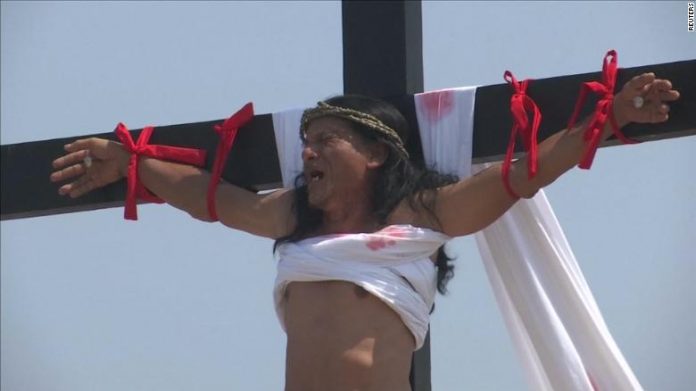A man playing the role of Jesus Christ during Holy Week in the Philippines was crucified for the 33rd time on Good Friday.
It’s part of a controversial Easter tradition in the country where people will undergo real-life crucifixions as an expression of their faith.
Since the 1980s, Ruben Enaje, 58, has portrayed Jesus Christ’s crucifixion and death on Good Friday in front of crowds of locals and tourists in a village north of Manila.
During these realistic crucifixions actors drive four-inch nails into both his hands and feet and lift him on a wooden cross for around five minutes. Enaje, who is Catholic, said he continues the tradition to remind the world about the plight of Jesus Christ, but he added he has decided to stop participating in the crucifixions after next year.
“I want to only do this until next year,” Enaje told Reuters. “What I’m looking for in my successor is that he serves as a good role model in his community and a person with good manners and values, not someone who would boast about the role or be too proud.”
There is great significance attached to the fact that this the 33rd time Enaje has done this. According to the Bible, Jesus was 33 years old at the time of his crucifixion.
Catholic officials discourage the crucifixions
The tradition has its origins in a play about Jesus written by a local playwright in the 1950s, which led to the first crucifixion in 1962. It has since grown into one of the most visually striking religious festivals in that part of the world and it attracts thousands of onlookers and tourists to watch the gory displays in the fervently Catholic nation. The crucifixions take place predominantly in the province of Pampanga.
Catholic leaders in the Philippines, however, condemn the practice, and the crucifixions are also discouraged by public health officials.First-aid personnel are on hand at the events, to help those who collapse from heat and dehydration, or who need their wounds treated.
Devotees say their wounds can take up to two weeks to heal but are a small price to pay to be able to express their faith through the extreme acts.In addition to the Good Friday crucifixions, other believers drag heavy crosses or crawl on bloodied hands and knees in cities and towns across the country. Others, dressed as Roman centurions, aid the voluntary crucifixions.
Two men and a woman were later crucified to wooden crosses after Enaje’s act. A total of nine people at three separate sites took part in crucifixions.
Source: CNN





